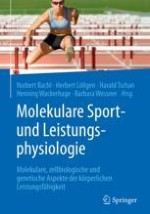Zusammenfassung
Herz-Kreislauf und Atmung sind Systeme, die jede Zelle des menschlichen Körpers, so auch die arbeitende Skelettmuskulatur, mit Sauerstoff und energiereichen Substraten für den aeroben Stoffwechsel versorgen und Stoffwechselendprodukte zur Metabolisierung transportieren. Sie unterliegen einer Gesetzmäßigkeit zur Funktions- (Prävention) und Morphologie-Maximierung, auch bei langdauernder körperlicher Inaktivität, nach Erkrankungen und Verletzungen. In den physiologischen und pathologischen Regelkreisen der Organsysteme sind Hormone, Substrate, Enzyme, Zytokine, und Botenstoffe auf molekularer Ebene (z. B. miRNA), eingeschaltet, um funktionelle Abläufe zu steuern. In diesem Kapitel wird von einfachen physiologischen Abläufen des Herz-Kreislaufsystems auf morphologische Veränderungen eingegangen, welche bei regelmäßiger körperliche Aktivität und Training erfolgen. Diese Regulations- und Adaptationsmechanismen werden hinsichtlich der prädisponierenden genetischen Voraussetzung wie auch der molekularen Abläufe dargestellt. Aufgrund der zentralen Bedeutung des Herzens wird auf physiologische und pathologische Veränderungen funktioneller wie morphologischer Art eingegangen. Es werden die wesentlichen diagnostischen Kriterien von EKG und der Ergometrie besprochen. Dazu gehören auch jene Gene, welche für Herz-Kreislauf-Erkrankungen verantwortlich sind und in Kap. 16 ausführlich dargestellt werden.











